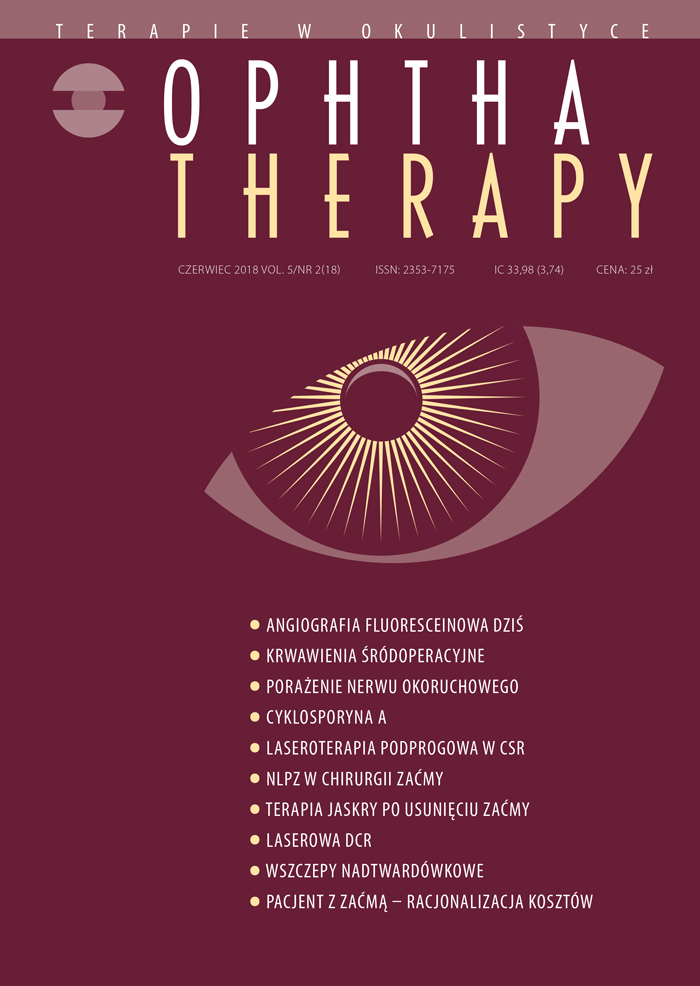Hemorrhage risk in patients undergoing ocular surgery
Main Article Content
Abstract
As a result of increasing volume of ophthalmic procedures and common use of antiplatelets or anticoagulants, the risk of using them in the perioperative period should be determined. The aim of this study was to assess the risk of bleeding in patients undergoing ophthalmic surgery based on current literature and to prepare polish recommendations in this field. Trabeculectomy, scleral buckling and vitrectomy in diabetic patients present high risk of bleeding. Phacoemulsification cataract surgery and intravitreal injections manifest low risk of intraoperative bleeding, and do not require a change in antiplatelet or anticoagulant agents dosage. Any preoperative dosage change in high-risk procedures should be consulted with the patient’s medical doctors and include an analysis of possible consequences.
Downloads
Article Details

This work is licensed under a Creative Commons Attribution-NonCommercial-NoDerivatives 4.0 International License.
Copyright: © Medical Education sp. z o.o. License allowing third parties to copy and redistribute the material in any medium or format and to remix, transform, and build upon the material, provided the original work is properly cited and states its license.
Address reprint requests to: Medical Education, Marcin Kuźma (marcin.kuzma@mededu.pl)
References
2. Kiire CA, Mukherjee R, Ruparelia N et al. Managing antiplatelet and anticoagulant drugs in patients undergoing elective ophthalmic surgery. Br J Ophthalmol. 2014; 98(10): 1320-4.
3. Gong D, Jun L, Tsai JC. Trends in Medicare Service Volume for Cataract Surgery and the Impact of the Medicare Physician Fee Schedule. Health Serv Res. 2017; 52(4): 1409-26.
4. Grzybowski A, Ascaso FJ, Kupidura-Majewski K et al. Continuation of anticoagulant and antiplatelet therapy during phacoemulsification cataract surgery. Curr Opin Ophthalmol. 2015; 26(1): 28-33.
5. Royal College of Ophthalmologists. Cataract Surgery Guidelines. Online: www.rcophth.ac.uk/wp-content/uploads/2014/12/2010-SCI069-Cataract-Surgery-Guidelines-2010-SEPTEMBER-2010.pdf. Published September 2010 (Access: 23.12.2017).
6. Kobayashi H. Evaluation of the need to discontinue antiplatelet and anticoagulant medications before cataract surgery. J Cataract Refract Surg. 2010; 36(7): 1115-9.
7. Salam T, Raines MF. Clopidogrel and intraocular surgery: complicated or uncomplicated? Grand Rounds. 2007; 7: 58-60.
8. Olson RJ, Braga-Mele R, Chen SH et al. Cataract in the Adult Eye Preferred Practice Pattern®. Ophthalmology. 2017; 124(2): P1-P119.
9. Chandra A, Xing W, Kadhim MR, Williamson TH. Suprachoroidal hemorrhage in pars plana vitrectomy: risk factors and outcomes over 10 years. Ophthalmology. 2014; 121(1): 311-7.
10. Oh J, Smiddy WE, Kim SS. Antiplatelet and anticoagulation therapy in vitreoretinal surgery. Am J Ophthalmol. 2011; 151(6): 934-9.e3.
11. Brown JS, Mahmoud TH. Anticoagulation and clinically significant postoperative vitreous hemorrhage in diabetic vitrectomy. Retina. 2011; 31(10): 1983-7.
12. Kanclerz P, Pyrzanowska-Sumiła J, Murawska J et al. Wylewy krwi w przebiegu proliferacyjnej retinopatii cukrzycowej leczone metodą witrektomii przez pars plana – materiał własny. Klin Oczna. 2013; 115(4): 291-5.
13. Grzybowski A, Kupidura-Majewski K, Kupidura P. Controversies in Anticoagulant Therapy in Vitreo-Retinal Surgery. Curr Pharm Des. 2015; 21(32): 4661-6.
14. Edmunds B, Thompson JR, Salmon JF et al. The National Survey of Trabeculectomy. III. Early and late complications. Eye. 2002; 16(3): 297-303.
15. Jampel HD, Musch DC, Gillespie BW et al. Perioperative complications of trabeculectomy in the collaborative initial glaucoma treatment study (CIGTS). Am J Ophthalmol. 2005; 140(1): 16-22.
16. Stein JD, Ruiz D Jr, Belsky D et al. Longitudinal rates of postoperative adverse outcomes after glaucoma surgery among medicare beneficiaries 1994 to 2005. Ophthalmology. 2008; 115(7): 1109-16.e7.
17. Gedde SJ, Schiffman JC, Feuer WJ et al. Three-year follow-up of the tube versus trabeculectomy study. Am J Ophthalmol. 2009; 148(5): 670-84.
18. Avery RL, Bakri SJ, Blumenkranz MS et al. Intravitreal injection technique and monitoring: updated guidelines of an expert panel. Retina. 2014; 34 Suppl 12: S1-18.
19. Xu Y, Tan CS. Safety and complications of intravitreal injections performed in an Asian population in Singapore. Int Ophthalmol. 2017; 37(2): 325-32.
20. Rosenfeld PJ, Brown DM, Heier JS et al. Ranibizumab for neovascular age-related macular degeneration. N Engl J Med. 2006; 355(14): 1419-31.
21. Brown DM, Michels M, Kaiser PK et al. Ranibizumab versus verteporfin photodynamic therapy for neovascular age-related macular degeneration: Two-year results of the ANCHOR study. Ophthalmology. 2009; 116(1): 57-65.e5.
22. Schmidt-Erfurth U, Eldem B, Guymer R et al. Efficacy and safety of monthly versus quarterly ranibizumab treatment in neovascular age-related macular degeneration: the EXCITE study. Ophthalmology. 2011; 118(5): 831-39.
23. Moon SW, Oh J, Yu HG et al. Incidence and risk factors for macular hemorrhage following intravitreal ranibizumab injection for neovascular age-related macular degeneration. J Ocul Pharmacol Ther. 2013; 29(6): 556-9.

